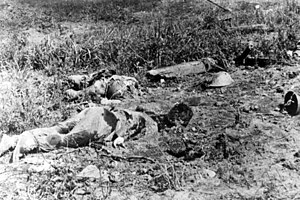| Battle of the Samichon River | |||||||
|---|---|---|---|---|---|---|---|
| Part of the Korean War | |||||||
 Chinese dead on the approaches to the Hook, late July 1953 | |||||||
| |||||||
| Belligerents | |||||||
|
| |||||||
| Commanders and leaders | |||||||
|
| Cheng Dengzhi[1] | ||||||
| Units involved | |||||||
| 137th Division | |||||||
| Casualties and losses | |||||||
|
|
UN claim: 2,000–3,000 killed Chinese claim: 886 casualties[2] | ||||||
The Battle of the Samichon River (24–26 July 1953) was fought during the final days of the Korean War between United Nations (UN) forces—primarily Australian and American—and the Chinese People's Volunteer Army (PVA). The fighting took place on a key position on the Jamestown Line known as "the Hook", and resulted in the defending UN troops, including the 2nd Battalion, Royal Australian Regiment (2 RAR) from the 28th British Commonwealth Brigade and the US 7th Marine Regiment, repulsing numerous assaults by the PVA 137th Division during two concerted night attacks, inflicting numerous casualties on the PVA with heavy artillery and small-arms fire. The action was part of a larger, division-sized PVA attack against the US 1st Marine Division, with diversionary assaults mounted against the Australians. With the peace talks in Panmunjom reaching a conclusion, the Chinese had been eager to gain a last-minute victory over the UN forces, and the battle was the last of the war before the official signing of the Korean armistice.
During the action, the PVA had attempted to make a breakthrough to the Imjin River along the divisional boundary between the US 1st Marine Division and the 1st Commonwealth Division to turn the Marine division's flank. Yet with well-coordinated indirect fire from the divisional artillery, including the 16th Field Regiment, Royal New Zealand Artillery, and support from British Centurion tanks of the 1st Royal Tank Regiment, 2 RAR successfully thwarted both assaults, holding the Hook. U.N sources estimated PVA casualties at 2,000 to 3,000 killed, with the majority of them inflicted by the New Zealand gunners. Meanwhile, on the left flank, US Marines had endured the brunt of the attack, repelling the PVA onslaught with infantry and artillery. Only a few hours later, the armistice agreement was signed, ultimately ending the war. Both sides subsequently withdrew 2 kilometres (1.2 mi) within 72 hours to create the 4-kilometre (2.5 mi) Korean Demilitarised Zone.
- ^ Hu & Ma 1987, p. 208.
- ^ "The History of People's Liberation Army" Volume 6 Page 209
© MMXXIII Rich X Search. We shall prevail. All rights reserved. Rich X Search
